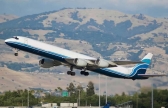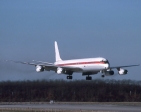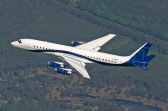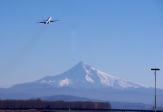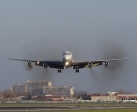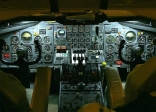
The Douglas DC-8 is a four-engined jet airliner, manufactured from 1958 to 1972 by the Douglas Aircraft Company. Launched later than the competing Boeing 707, the DC-8 nevertheless established Douglas in a strong position in the airliner market, and remained in production until 1972 when much larger designs, including the DC-10 and Boeing 747, made the DC-8 obsolete. Relegated to second-line duties, details of the DC-8 design allowed it to hold slightly more cargo than the 707; dozens of re-engined examples remain in freighter service to this day, while commercial 707 service had largely ended by 2000.
Boeing's plans became obvious in the industry, in spite of their "code name" intended as a disinformation tactic. Douglas secretly began jet transport project definition studies in mid-1952. By mid-1953 these had developed into a form very similar to the final DC-8; an 80-seat, low-wing aircraft with four Pratt & Whitney JT3C turbojet engines, 30° wing sweep, and an internal cabin diameter of exactly 11 ft (3.35 m) to allow five abreast seating. Maximum weight was to be 95 tons (86 tonnes), and range was estimated to be about 3,000-4,000 mi (4,800-6,400 km).
Douglas remained lukewarm about the jet airliner project, but believed that the Air Force tanker contract would go to two companies for two different aircraft, as several USAF transport contracts in the past had done. In May 1954, the USAF circulated its requirement for 800 jet tankers to Boeing, Douglas, Convair, Fairchild, Lockheed, and Martin. Boeing was already just two months away from having their prototype in the air. Just four months after issuing the tanker requirement, the USAF ordered the first 29 KC-135s from Boeing. Even leaving aside Boeing's ability to supply a jet tanker promptly, the flying-boom air-to-air refueling system — as first fitted to the KC-97 — was also a Boeing product: developing the KC-135 had been a safe bet.
Donald Douglas was shocked by the rapidity of the decision which, he said, had been made before the competing companies even had time to complete their bids. He protested to Washington, but without success. Having started on the DC-8 project, Douglas decided that it was better to press on than give up. Consultations with the airlines resulted in a number of changes: the fuselage was widened by 15 in (38 cm) to allow six-abreast seating. This led to larger wings and tail surfaces and a longer fuselage. The cost of the program was enormous; it was at that time the most expensive venture of any kind ever taken on by a single company.[citation needed] Donald Douglas provided $450 million towards it out of his own pocket.
The DC-8 was officially announced in July 1955. Four versions were offered to begin with, all based on the same 150 ft 6 in (45.9 m) long airframe with a 141 ft 1 in (43 m) wingspan, but varying in engines and fuel capacity, and with maximum weights of about 120-130 tons (109-118 tonnes). Douglas steadfastly refused to offer different fuselage sizes. The maiden flight was planned for December 1957, with entry into revenue service in 1959. Well aware that they were lagging behind Boeing, Douglas began a major push to market the product.
Plane info
Cruise speed: 946 km/h
Total range: 7 410 km
Engines: 4 x Pratt & Whitney JT4A-9 turbojets
Aircraft dimensions
Wingspan: 43.41 m
Length: 45.87 m
Height: 13.21 m
Cabin
Passengers: up to 124

